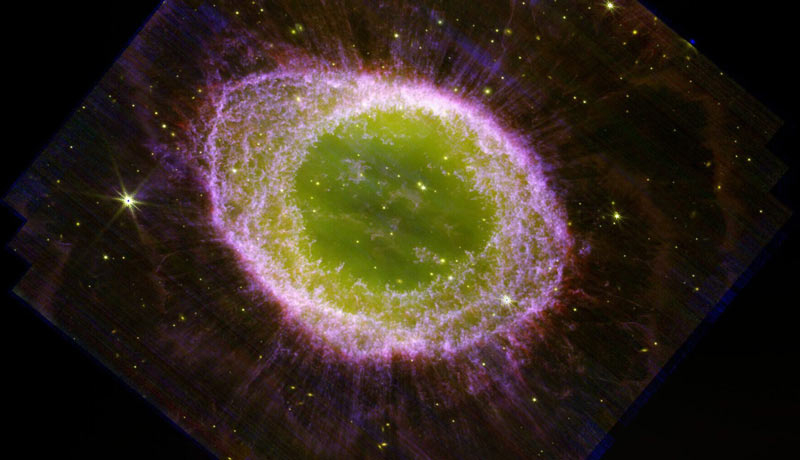
Another stunning photo from James Webb: In the center of the Ring Nebula, you can see the remains of a white dwarf that has shed its shell (photo, video)
The James Webb Space Telescope took another stunning photo: one of the most attractive objects to observe, the planetary Ring Nebula (Messier 57, M57), fell into its lens. This is the scattered shell of a large star, larger than our Sun in size, which has completed its life path. Fans are interested in watching this object, because it is bright, colorful and interesting. Professionals are also interested in it - using it as an example, they can study the final evolution of stars.
The new image of the Ring Nebula was captured using the NIRCam near-infrared camera and special narrow-band filters. At the center of this breathtaking image is a white dwarf, the remnant of a star after its outer shell was ejected in the later stages of its evolution.

According to scientists, a similar fate awaits our Sun: in the distant future, it will also become a red giant with a huge bloated shell and eventually shed it. The ejected gas and materials will spread throughout the solar system and sweep away everything in its path, including the Earth's atmosphere.
Although the phenomenon seems truly terrifying, it looks aesthetically pleasing, especially in such detail, as provided by the James Webb telescope. The image shows vortices and clusters in areas where the stellar shell collides with the cold gases of space.
From the picture obtained by the telescope, scientists can analyze the dynamics of the expansion of the star's shell. In addition, the telescope's instruments are capable of spectral analysis of the material, and given the proximity of the Ring Nebula to us (approximately 2,500 light-years - quite close on a cosmic scale), scientists were able to determine the composition of the shell, including an amazing abundance of molecules with a carbon compound.
- Related News
- Wheel of Death: new method will help astronauts stay fit in low gravity
- Due to anomalies of Orion spacecraft, lunar exploration program may be delayed for years։ NASA
- TAO Observatory: World's highest telescope to study evolution of galaxies and exoplanets
- Powerful M9.5 solar flare causes radio blackout in Pacific Ocean
- What will happen to the Earth if the Moon disappears?
- Key to conquering the Red Planet: Why is NASA studying solar storms on Mars?
- Most read
month
week
day
- Digital Julfa Network is launching a pan-Armenian centre in the metaverse, on the Fastexverse virtual platform 903
- Sparkles: Boston Dynamics unveils a furry robot dog that can dance (video) 789
- Xiaomi unveils exclusive Redmi Note 13 Pro+ dedicated to Messi and Argentina national team 774
- Is there a ninth planet in the solar system? Scientists find new evidence 669
- Smartphone catches fire in child's hand in Russia 654
- What will happen to the Earth if the Moon disappears? 643
- How to understand how protected a smartphone is from water and dust? 633
- World's largest 3D printer was created in USL It prints 29 meter-long structures 619
- iPhone 16 may get colored matte glass back panel, 7 colors 609
- New iPad Pro to receive M4 chip and to be more powerful than Apple computers 605
- Archive
